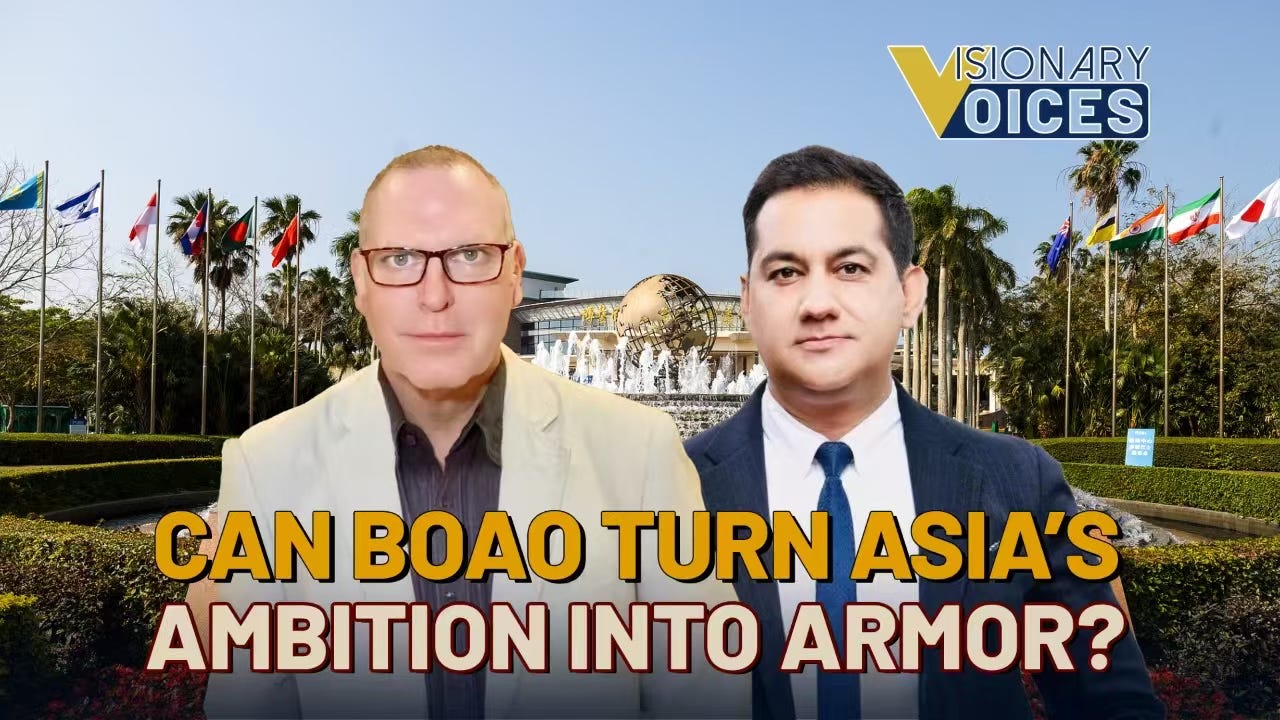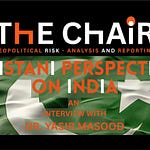By Yasir Masood (CGTN)
Editor's note: CGTN's First Voice provides instant commentary on breaking stories. The column clarifies emerging issues and better defines the news agenda, offering a Chinese perspective on the latest global events.
Asia's push to lead in green and digital innovation faces fractured supply chains and geopolitical divides. Can ambition outpace division? The Boao Forum for Asia (BFA) Annual Conference 2025 tackles these challenges head-on, with Australian strategist Dr. Digby James Wren charting a path forward: turn dialogue into infrastructure, scale China's innovation engine and unlock financing for AI and green tech.
With RCEP and ASEAN as anchors, Dr Wren advocates unified markets, seamless data flows, and grassroots partnerships. But in a world of tariffs and fragmentation, can multilateralism still prevail? Boao's answer: trust-driven progress, where talk becomes tomorrow. Next, Dr. Wren on bridging promises and progress.
Translating policy discussions into economic impact
Dr. Wren: The Boao Forum is a really great platform for Asia, and (specifically for) Southeast Asia. Translating policy discussions like Boao into actionable initiatives is not necessarily an easy thing to do, but it drives economic impact.
The things that are really important at the moment are turning dialogue into action is the key, and institutionalizing the follow-up mechanisms and working groups, converting ideas into blueprints, and developing permanent bodies.
Scalability is another thing. I think that's very important, getting things done at speed and scale are really the hallmarks of China's innovation. The Boao Forum enables a platform to do that. So, I'd like to see more innovation models that can be applied to different countries, for example, to Pakistan, Cambodia, Malaysia, Indonesia and Vietnam.
And mobilizing finance. I think finance is another area where there's not enough input, and it isn't easy to get the contacts you need at the right time for financing.
And then probably the last one is prioritizing digital and green. And I think that's really key. China's leading in that area globally, and I'd like to see that being pushed or supported more strongly right across all of the partner countries in Asia. And then I suppose the last one would be stakeholder engagement.
But progress demands more than ambition; it needs armor. From Cambodia's logistics bottlenecks to Indonesia's rail breakthroughs, Asia's supply chains are rewriting resilience. Dr. Wren cuts to the core: Strengthen access, unify systems, prioritise stability. Now, he tackles the trillion-dollar question: How do we futureproof growth in a fragmented world?
Reciprocal tariffs and regional resilience
Dr. Wren: Intermediate goods, especially Chinese intermediate goods, need clearer access to those new near shoring supply chains. That's important. Resilience of the supply chains is clearly going to have to be strengthened and prioritized. For example, some countries, like Cambodia, it is still very difficult. But there are some bright spots here, the Laos-China railway, Indonesia's railway from Jakarta to Bandung, that's an uplift.
Geopolitical fragmentation is very problematic. That fragmentation is really caused by pressure that's being caused by mostly the United States and Europe. China is providing the greatest level of stability for Southeast Asia, for Central Asia, and right across Asia.
Resilience is being built rail by rail, policy by policy. But as supply chains stabilize, a tougher test looms: Can Asia's economic alliances outpace geopolitical divides? Dr. Wren shifts focus to the rules of engagement:
"Inclusive multilateralism isn't optional. It's survival."
From RCEP's unifying power to battling digital Balkanisation, he charts a path where Huawei bridges ASEAN and where Boao becomes the ultimate toolkit. Dr. Wren unveils the strategy: How multilateral frameworks turn fractures into footholds.
Navigating geopolitics and economic trajectory
Dr. Wren: Inclusive multilateralism is the end way to go here. Boao needs to concentrate on the ones we do have, the networks that are already in place, like ASEAN and RCEP, that's perfect; in Central Asia, with the existing economic blocks; and also the regional ones with the partners in Africa and South America, to reduce fragmentation and create a more unified market. For example, ASEAN especially is a clear winner because it is the biggest trading partner for China.
RCEP is also providing a positive magnetic force, which is good for Australians, New Zealanders, Japanese and South Koreans.
Companies in China, like Huawei, Xiaomi and others, can all be involved in better governance, I think, communication governance and data-sharing governance. That needs to be looked at fairly closely.
We don't want the Balkanization of all these ASEAN countries just because they don't want to connect to their storage systems. We need a toolkit for that, I suppose. Boao would be a very good way to set up a toolkit for doing that.
Asia's future hinges on three pillars: speed, scale, and solidarity. From the Laos-China railway to RCEP's game-changing sway, Dr. Wren's playbook is clear: Turn debate into bridges. Turn friction into frameworks. Turn divisions into drive. This isn't about trade spats. It's about rewriting the rules. From Huawei's digital leaps to grassroots grit, Boao is Asia's ultimate toolkit. The race isn't against rivals. It's against the clock. And the finish line? A world where shared futures aren't just debated. They're built.
https://news.cgtn.com/news/2025-03-27/Can-Boao-Forum-turn-Asia-s-ambition-into-armor--1C5hnvrF89G/p.html
5G-Advanced: The Backbone of the AI Revolution
By Dr. Digby James Wren
The convergence of artificial intelligence (AI) and 5G-Advanced (5G-A) networks marks a pivotal shift in technological capability, reshaping industries, governance, and daily life. As Yang Chaobin of Huawei emphasised at the recently concluded 2025 World Mobile Congress (WMC) in Barcelona Spain, “5G-A is not merely an upgrade—it is the foundation for unlocking AI’s full capabilities.” With over 60 telecom operators globally deploying 5G-A, its role in powering AI-driven solutions—from smart factories to telemedicine—positions it as the critical infrastructure for a globally interconnected future.
The technical foundations of 5G-A, colloquially termed “5.5G,” build on 5G, but with three transformative enhancements: Ultra-High Uplink Speeds (up to 10 Gbps), essential for data-intensive applications like industrial sensors and real-time drone feeds; Near-Zero Latency (<10 milliseconds), enabling instantaneous decision-making for robotics, autonomous vehicles, and remote surgeries; and, Network Slicing, which allocates dedicated bandwidth for specific AI tasks to ensure reliability. These three core advancements address inefficiencies in latency-sensitive environments, allowing AI systems to operate at peak efficacy.
For example, AI-driven robotic arms in manufacturing require millisecond-level adjustments based on sensor feedback—a feat unachievable with traditional networks. Huawei’s collaboration with manufacturers reduced production errors by 30% using 5G-A-enabled systems. Similarly, autonomous drones, such as those deployed by JD Logistics in China, leverage 5G-A’s low latency and high uplink speeds to process LiDAR data in real time, slashing delivery times by 50%.
Huawei’s AI-Centric Network Solution, presented at WMC 2025, focuses on three pillars of the AI driven economy: All-Domain Connectivity which ensure universal ultra-high speeds for AI applications; Predictive Operations that drive AI managed maintenance initiatives to reduces downtime by 60%; and, Experience Monetization allowing online services like gaming companies and education providers to offer tiered services such as premium latency for students and gamers.
In gaming crazy South Korea, 5G-A connected AI systems in homes adjust energy use based on occupancy, saving families an estimated US$600 annually. Adidas is using AI-driven 5G-A systems to add customisation at scale and produce personalised sneakers in 48 hours (vs. 2 weeks), enabling it to capture a US$2 billion niche market. And, in customer engagement, Augmented Reality shopping, such as L’Oréal’s 5G-A-powered AR app, lets users “try on” makeup virtually, boosting online sales by 35%,through virtual makeup trials. Additionally, wearable devices like Huawei’s 5G-A-enabled watches can detect irregular heartbeats with astounding accuracy, alerting users to seek care before emergencies.
Economic growth and business innovation rely on improved education outcomes. Education equity and personalised learning are being transformed by AI technologies. In Kenya, AI tutors on 5G-A networks adapt lessons to student needs, boosting literacy rates by 25%. In Mongolia, Huawei’s VR-enabled classrooms connect students to global institutions, bridging geographic divides.
The transformation in smart manufacturing and autonomous systems are increasingly powered by the deterministic performance of 5G-A. Siemens’ predictive maintenance tools, integrated with 5G-A, reduced downtime by 60% at its Munich plant, saving €200 million annually. In logistics, Maersk’s AI platform on 5G-A predicts shipping delays with 95% accuracy, saving US$3 billion annually, while Amazon’s smart warehouses utilize 5G-A-connected robots to enable same-day delivery for 90% of US customers. Vietnam’s 5G-A smart ports cut cargo processing times by 40%, which in-turn has helped attract US$12 billion in logistics investments.
Another key benefit of the AI transformation is an emerging healthcare revolution built on 5G-A’s unmatched reliability for critical telemedicine, remote surgeries and AI diagnostics. During a recent trial in Shanghai, surgeons performed a kidney transplant using 5G-A-connected robotic arms controlled from 1,500 km away, demonstrating life-saving potential by performing delicate procedures with sub-10ms latency. In rural India, AI-powered telemedicine platforms using 5G-A’s low latency (<10ms) connect patients to specialists in cities, reducing diagnostic delays by 70%. Moreover, AI models on 5G-A networks can analyze global health data in real time, predicting outbreaks, such as Covid, weeks in advance. During the 2024 dengue surge in Brazil, this system enabled targeted mosquito control, cutting cases by 40%. These significant breakthroughs are near-impossible without 5G-A’s flawless connectivity.
AI Ecosystems, Smart Governance and Sustainable Agriculture also depend on uninterrupted data flow. China Mobile’s “smart mines” harness AI analysis of geological data to prevent accidents, while in Middle East oil refineries the new AI technology is used to predict equipment failures. Deutsche Telekom’s AI-driven tractors enable the optimisation of agricultural planting patterns across Europe. In Nigeria, farmers are now using 5G-A-connected drones and AI to monitor soil health to increase yields by up to 50% while reducing water usage by 35%.
Governments have been taking notice. The EU anticipates that AI driven advancements will create four million new tech jobs by 2030, which can offset job losses to automation. 5G-A for Smart Cities and smarter governance use AI systems to manage traffic lights, energy grids, or emergency responses. In Shenzhen, 5G-A networks support city-wide AI platforms that reduce traffic congestion by 25% and cut emergency response times by 40%. In Barcelona, AI-managed traffic systems, powered by 5G-A, reduced congestion by 30% and CO2 emissions by 15%. South Korea’s AI chatbots handle 80% of citizen inquiries, saving US$500 million annually and Japan’s flood prediction systems provide 90-minute warnings, saving thousands of lives during typhoons and earthquakes.
Despite initiatives like the WTO’s 2025 Digital Trade Agreement, which aims to harmonize AI ethics and data policies across 100+ nations, the enormous benefits that accrue to society through the rapid adoption and deployment of AI and 5G-A still face three critical hurdles.
First, Infrastructure costs for the deployment requires investment in mmWave antennas and edge servers; second, standardization requires global collaboration to avoid fragmented protocols, and third, robust security systems, encryption and governance frameworks need further optimization to protect the rapid rollout of AI systems. Despite these challenges, 5G-A adoption has reached a tipping point, driven via its critical role as a catalyst for efficiencies and predictive systems that spur economic growth.
To ensure a Smarter Future, AI and 5G-A can be understood as symbiotic forces that together drive efficiency, equity, and innovation. Industries achieve precision, governments enhance public services, and individuals gain unprecedented connectivity. Huawei’s vision of 5G-A as the “bridge between AI’s ambitions and real-world execution” underscores its transformative potential. By combining 5G-A with AI, societies can advance trade efficiency, attract investment and empower SMEs, fostering an inclusive, sustainable global economy. The AI future is not merely intelligent - it must be resilient, interconnected, and equitable.
NB: NB: The author is chair, Belt and Road Capital Partners — A Geopolitical Risk, Trade and Investment and Education Partnership Advisory Firm with offices in China, Europe, ASEAN and Australia.















Share this post